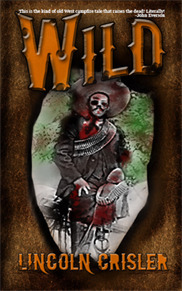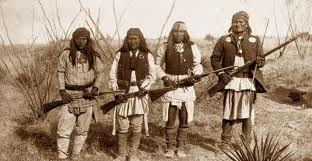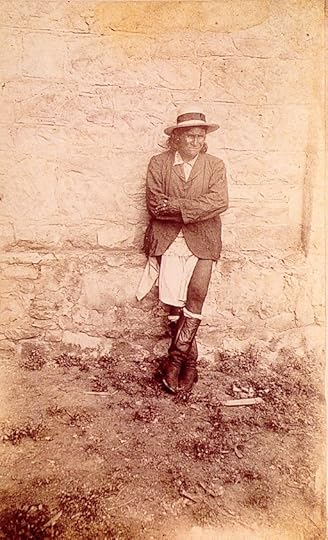Edward M. Erdelac's Blog, page 40
March 15, 2011
Something WILD – Author Lincoln Crisler
Hey all, this time out I'm letting a fellow weird western author take a stroll down the main street of Delirium Tremens while I kick back on the porch. Specifically, author Lincoln Crisler, who's zombie novella WILD is out now from Damnation Books, the fine folks who publish my Merkabah Rider series. This is what DB has to say about it…
'When Colonel Albert Waters, a controversial Civil War veteran, and his thirteen-year-old son Henry disappear from their El Paso, Texas home, Deputy Sheriff Kurt Kearney calls upon Matthias Jacoby, a strange newcomer, to help with his investigation. Word is, Jacoby's handled a few cases like this before. Kearney and Jacoby form an uneasy alliance with Black Tom Catch, an infamous New Mexico rancher, cattle rustler and outlaw, and take off after the bandits they suspect kidnapped Waters.
Could the gunfighters have bitten off more than they can chew, however, when their search for the colonel reveals strong ties to black magic and blood sacrifice?'
I spoke with Lincoln about writing and about WILD. Here's what we talked about.
EME: Tell me first about yourself, Lincoln.
LC: I'm twenty-eight years old, married with two daughters and a son and I've been in the Army for ten years. I've been to Korea, Iraq, Afghanistan and Qatar for a year each. I like beer and cigars. And I write scary stuff.
EME: Hope this doesn't come off as too personal, but I've always been curious about your nom de plume. Is Lincoln Crisler your given name?
It is my given name. "Crisler" is actually pronounced as though it were spelled "Crissler" and my mother's maiden name (no shit) is Ford.
EME: As a father of three and a half myself, I'm usually forced to just drop into writing mode minuteman style whenever my youngest crashes. Do you have difficulty making time to sit down and write? What's your prescribed method of dealing with that?
LC: It's pretty easy for me to just jump on and do website maintenance, book reviews and promotional activities, but the actual writing? It's easier when I'm deployed, honestly. By the time all my other obligations are dealt with, I have no energy left to write. If I can't get it in before work or on my lunch break, it isn't getting done that day. When I'm out of the Army in ten years I'll be able to get up early or stay up late, but right now it isn't an option, since I'm already doing that!
EME: Now let's talk about WILD a little bit. Give us the gyst.
LC: WILD is loosely based on a real unsolved missing persons case from Old West El Paso. A prominent citizen and war hero disappeared with his son and was never seen again. I changed a few things around for artistic reasons, borrowed the names of some peripheral characters and added some black magic and zombies, a mysterious stranger and a former Army medic. There's a bit of sleuthing, a touch of the supernatural and plenty of gunplay…something for everyone!
EME: What induced (possessed might be a better word) you to write a weird western story?
LC: I wanted to write about zombies and magic without using a worn-out modern setting and familiar modern horror tropes. When I was looking for fodder from that period of time, Colonel Fountain's disappearance popped out at me. Unsolved mysteries make great beginnings for horror stories!
EME: I'm always intrigued by the appearance of obscure folk practices in dark fiction. In WILD you feature a hechichero. Tell me how you came across them.
LC: Google. I'm familiar with Southwestern American mystical practices least of any in the world (Jewish mysticism would have beat it out, but I've been staying on top of the Merkabah Rider series!). It's a fair assumption to make that any civilization that believes in magic has good wizards and bad wizards. In the case of Mexican mysticism, these are curanderos and hechiceros, respectively. It was important to me not to take the easy way out and just use the standard "Evil Medicine Man." I put entirely too much work into the plot and settings to take a step back like that. A little research usually ends up saving your ass.
EME: Another thing I like is the name dropping of obscure deities. Not being too familiar with the Aztec pantheon (but having always been interested in learning more), Tetzacatlipoca jumped out at me. Talk a little about this guy without giving too much away.
LC: Tezcatlipoca was a very important Aztec god, who is mentioned frequently alongside Quetzalcoatl in creation myths and such. He was associated with such things as magic, divination and temptation, which makes him a great choice for my hechicero's patron. Again, I wanted to put in some extra effort instead of just having my bad guy "worship the Devil."
EME: WILD came across like the beginning of something. Will we see more of Matthias Jacoby's adventures? Will we learn more about his past?
LC: I left it open-ended as to whether there'll be more Matthias. Early readers seem to like the book, so I'd be an idiot not to revisit him. I don't know when or in what form I'll come back to Matthias and Juan, though. I will say that Sherlock Holmes was an influence on WILD from the get-go, so there'll probably be more mysteries. I also have a short story in mind featuring the origin of the zombie magic used in WILD; it won't be set in the Wild West, however. And there might be some leftover zombies from Matthias' adventure, so that might be good for a story, too!
EME: Where can folks pick up a copy of WILD?
LC: WILD is available in digital and paperback formats from Damnation Books, and there are still a few copies of the 26-copy lettered hardcover that I produced myself. More information on all of these, to include excerpts and reviews, can be found at http://lincolncrisler.info
That's about all this time around. How about that cool cover from Ash Arcenaux too?
-Hasta Pronto!








February 26, 2011
Little China, The Rock, The Emperor, and Cannery Row
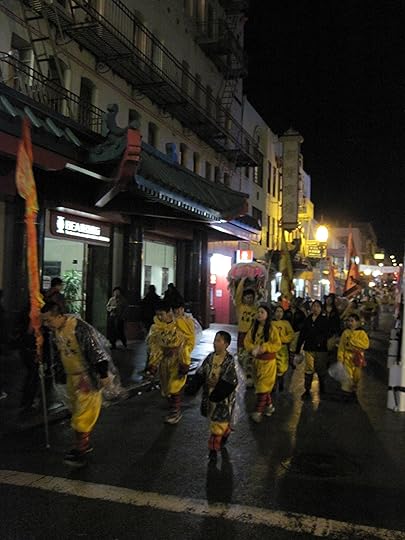 Having missed out on Wild Wild West Con, I decided to take the family up north for a proper vacation and see not only the big Chinese New Year parade in San Francisco, but also some sites I had been meaning to see for some time.
Having missed out on Wild Wild West Con, I decided to take the family up north for a proper vacation and see not only the big Chinese New Year parade in San Francisco, but also some sites I had been meaning to see for some time.
We set out on Friday and ploughed through torrential downpours most of the way. Coincidentally my wife's friend was house sitting her parents' place, so we decided to stop over in Fresno and spend the night there, saving on a night's worth of hotel stay and catching up.
Saturday morning we went the rest of the way up to SF, and wound up staying at a Motel 6 in Oakland. I've never been to Oakland before, and don't see a reason for ever going back. Bit on the skuzzy side. The most interesting thing we saw there was a Lexus painted two tone yellow and green, like a taxicab. Lexus and Mustang drivers are the worst drivers in America. Lexus drivers almost universally seem to be either oblivious to the rules of the road, or assume they somehow don't apply to them. Mustang drivers think they're skillful drivers, but from what I've seen, usually can't handle their cars.
We got to Chinatown in time for the start of the parade. It's a great show, the largest of its kind in the U.S. The rain had slowed to a tolerable drizzle, not nearly enough to put a damper on the dragon dancers or to interfere with the bricks of firecrackers. My daughter had enough after about forty minutes however, and we went over to Four Seasons, the three story restaurant on the main drag in Chinatown that we usually visited on past excursions. Unfortunately the entire place had been booked by a private party (likely the mayor, as the last time we were there he showed up with his entourage a little after we arrived), so after a bit of hunting we came across a place called The Chinatown Restaurant. Out front a lady thrust a flyer at us, and promised us the food was good. The flyer announced the 92nd anniversary of the place, and offered free pot stickers, so we figured why not?
 It was cold inside (enough to see your breath), and the ground floor was wet and spread with drop cloths. We went up to the second floor and were seated pretty quickly, three and a half of us to a two person table (it was pretty crowded). We had to get our own menus and the waitress didn't speak English, but the Mongolian Beef and Kung Pao Chicken was fantastic and the Tsingtaos were three bucks. I enjoyed it as an alternate.
It was cold inside (enough to see your breath), and the ground floor was wet and spread with drop cloths. We went up to the second floor and were seated pretty quickly, three and a half of us to a two person table (it was pretty crowded). We had to get our own menus and the waitress didn't speak English, but the Mongolian Beef and Kung Pao Chicken was fantastic and the Tsingtaos were three bucks. I enjoyed it as an alternate.
After a debilitating hike back up to the parking garage we retired for the night.
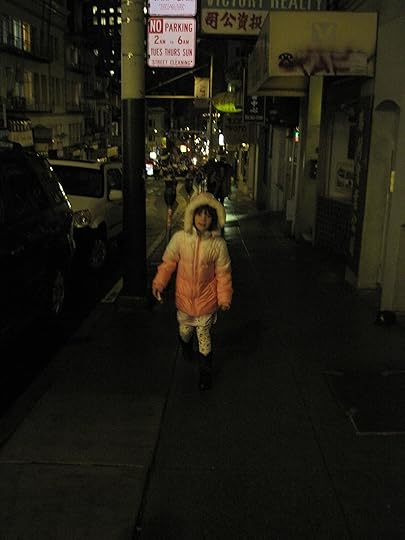
Big Trouble in Little China
In the early morning we packed up and set out for Alcatraz as my wife had never been there. The ferry over was nice. The girls were particularly thrilled. Even the baby seemed to be ecstatic at everything she saw.
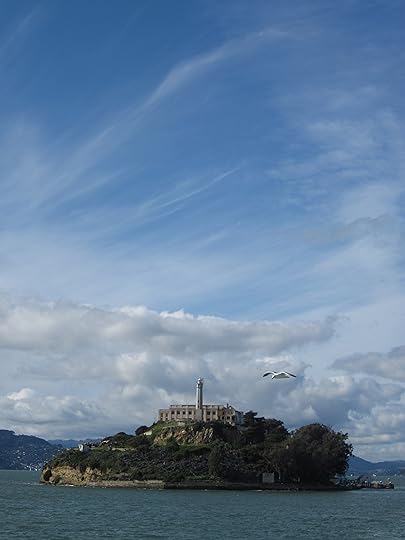 The last time I'd been to the Rock I was probably eight or nine years old and not nearly as appreciative of the history. I was particularly interested in the stuff about the Native American Indian political occupation of the island in the 70's. Some of the buildings still bear graffiti relating to that, though I could swear that as a kid it wasn't there, nor did I remember any presentations about the event. It's possible my parents weren't interested and so steered me away from it, but the 'Indians Welcome' tag is so prominent when you get off at the dock I'm surprised I have no memory of it.
The last time I'd been to the Rock I was probably eight or nine years old and not nearly as appreciative of the history. I was particularly interested in the stuff about the Native American Indian political occupation of the island in the 70's. Some of the buildings still bear graffiti relating to that, though I could swear that as a kid it wasn't there, nor did I remember any presentations about the event. It's possible my parents weren't interested and so steered me away from it, but the 'Indians Welcome' tag is so prominent when you get off at the dock I'm surprised I have no memory of it.
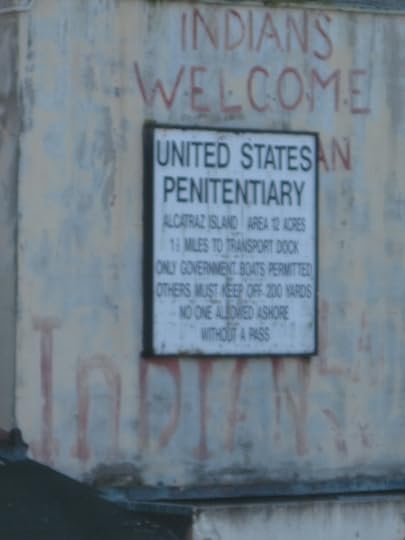
Grafitti left over from the Native American occupation
Another aspect of the prison that fascinated me this time around was the block of cells at the corner of Michigan Avenue (the rows between the cell blocks were given street names, like Broadway, etc.). These cells were apparently the most desirable as the sun shined through the high windows into the cells here.
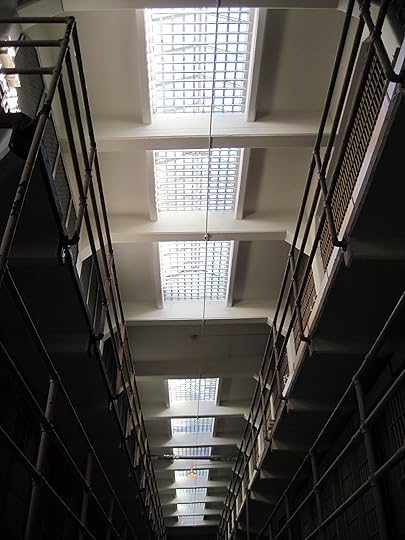
The sky over Broadway
The local yacht club also held an annual New Years Eve party and one of the prisoner narrators on the audio tour said that when the breeze blew in a certain direction the prisoners here could actually smell the food and liquor, and hear the laughter of men and women, reminding them of all they were missing out on on the outside.
I also learned that in the mid 19th century many hostile Indians were briefly incarcerated on the island. I had read recently that Geronimo had been imprisoned for a time at the Presidio, but I wonder if he saw or spent time on Alcatraz….
I think my daughter was a little bored, but my wife and I enjoyed ourselves. After returning to the mainland, I decided to take them to the Palace of Fine Arts, which is a magnificent columned structure and lagoon constructed for the 1915 Panama Exhibition.
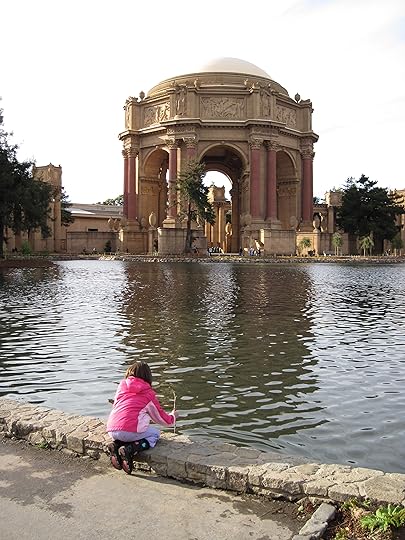
Nolie on Naboo....er....at The Palace of Fine Arts
Three quarters of San Francisco had the same idea though, and I spent forty minutes driving around looking for parking with the baby asleep in back while my wife and eldest daughter enjoyed the park. I finally found a spot and was backing into it when they appeared alongside the car, ready to depart.
From there we headed to Colma, California. This place is very nearly a modern day necropolis, with four or five expansive cemeteries located along the same stretch of road within minutes of each other. Colma is the burial place of many early luminaries. I was there to see Emperor Norton I's final resting place at Woodlawn Cemetery and the graves of Wyatt and Josie Earp at the neighboring Hills of Eternity.
For those who don't know of Joshua Norton, well, look him up on wiki. An eccentric Englishman who lost his fortune and his mind in an ill-fated rice venture, Norton turned up on the streets of San Francisco in a raggedy uniform and plumed hat, issuing imperial proclamations to the Chronicle office (which they snidely printed). Norton declared himself Emperor of the United States and Protector of Mexico.
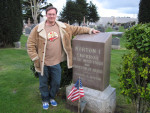
The Emperor and I
The citizens of San Francisco humored him, honoring his homemade currency and saving him a complimentary box in the theaters and free seating in the restaurants. He was a unique soul and a visionary besides. He decreed the building of the Bay Bridge and Transbay Tunnel 53 years before the plan was taken seriously and implemented. A contemporary of Mark Twain and Ambrose Bierce, his funeral was an elaborate, well-attended affair.
And Wyatt and Josie Earp, well, if you're reading this blog you very likely know who they were.
The kids both crashed after the inordinately long trek through clogging traffic, and by the time we got there there was no one around in the way of caretakers. I spent a good twenty minutes doing my best impression of Tuco jogging amid the tombstones, squinting at the names in the fading light before my wife honked the horn at me and showed me a picture of the actual tombstone in the biography of Norton I'd packed along. I identified a column in the background and found the grave of the 'Empress' first, with Norton behind. Took a few pictures, and at my wife's suggestion, left a Twinkie on His Majesty's tombstone (it was all I had handy). Unfortunately it slipped into the water-filled face and challenged the spongey-ness of the sponge cake to the breaking point.
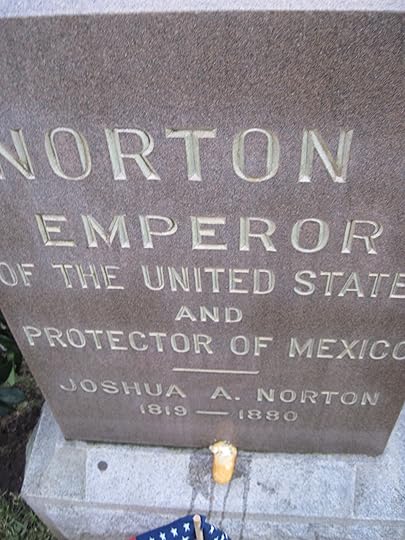
My golden offering is sadly waterlogged.
Dropped the wife and kids off at Subway (they were starving) and headed back to Hills of Eternity, but found it roped off. I was very disappointed there, having come so far physically and metaphorically (I visited Wyatt's birthplace in Monmouth, Illinois back in college). I was quite tempted to run the risk of trespassing, but seeing as how I'd left the family at a foreign Subway and my wife's phone was in the car, I decided I'd better not risk it, particularly since the Colma Police Department was only a few doors down.
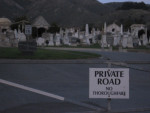
Somewhere in that necropolis Wyatt and Josie lay....
We drove a few hours out of town and spent the night in Monterrey. After being turned away like Mary and Joseph from several of the big chain hotels (busy holiday weekend), we stayed at the quite tasteful (and cheap) Casa Verde Inn. No internet, but more cable channels than the Motel 6 in Oakland, and much cleaner and nicer. Fell asleep switching between Superman The Movie and Attack of the Clones. The owner was very pleasant.
All of Monterrey was quite hospitable, actually. We took the kids to the Aquarium on Cannery Row.
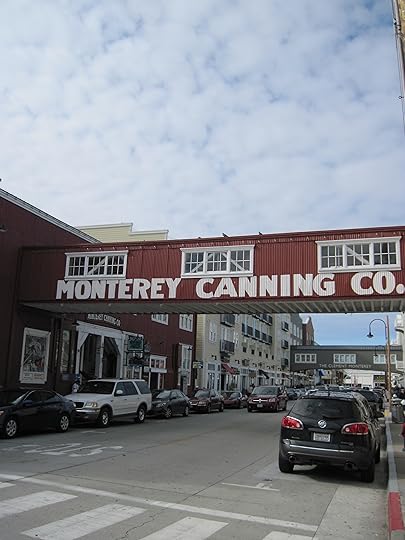
Cannery Row
A lot's changed since Steinbeck's days. Very touristy now, and all the old sardine canneries house trendy chain restaurants and pirate themed gift shops. Lee Chong's isn't around anymore, but there was a bronze bust of the man himself, next to Bubba Gump's (a restaurant that may not deserve my spite, but I can't help it because it's named after a movie that does deserve it).
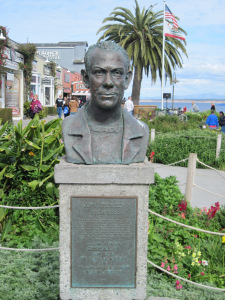
The Bear Flag no longer has the biggest bust on Cannery Row....
The old Hovden Cannery is now the site of the Monterey Aquarium, where we spent most of the day.  The jellies and sea dragons always mesmerize me, but we were unanimously taken in by the site of the schools of sardines. Once the staple commissary of Cannery Row, they mainly exist here in the aquarium after having been overfished years ago (when asked where all the sardines went, marine biologist Ed Ricketts replied 'They're all in cans.'). They move in lovely patterns, more imaginative than but with the same precision as flocks of bats and birds, inadverdantly forming these complex geometric patterns of flitting, living silver. In the picture I took, the fish had only just commanded the center of their tank in a beautiful ever-revolving sphere. They broke apart just as I snapped the photo.
The jellies and sea dragons always mesmerize me, but we were unanimously taken in by the site of the schools of sardines. Once the staple commissary of Cannery Row, they mainly exist here in the aquarium after having been overfished years ago (when asked where all the sardines went, marine biologist Ed Ricketts replied 'They're all in cans.'). They move in lovely patterns, more imaginative than but with the same precision as flocks of bats and birds, inadverdantly forming these complex geometric patterns of flitting, living silver. In the picture I took, the fish had only just commanded the center of their tank in a beautiful ever-revolving sphere. They broke apart just as I snapped the photo.
We lunched on crab-encrusted salmon, clam chowder, and cheeseburgers at Fisherman's Cove on Fisherman's Wharf, watched the sea lions float by. My daughter took pictures with several exotic birds, hustled us for some souvenirs, then we swung for home.








February 8, 2011
One Who Yawns
Having nearly reached the mid-point on the next installment in my Merkabah Rider series Have Glyphs Will Travel, I decided to take some time out to talk a little about one of the characters appearing in the second (and as yet unnamed) episode.
A lot happens in this book, as the series enters the home stretch. Key details of the Hour of Incursion plot will be revealed, the succubus Nehema will return, and the Rider' s nemesis Adon will finally make an appearance.
Historical characters have appeared in Merkabah Rider before. 'Mysterious' Dave Mather and John 'Doc' Holiday featured prominently in The Mensch With No Name, as well as members of Las Vegas, New Mexico's infamous Dodge City Gang. Tales of a High Planes Drifter had Josephine 'Sadie' Marcus, the future wife of Wyatt Earp, and her shiftless beau and soon-to-be Cochise County Sheriff, Johnny Behan.
With Have Glyphs Will Travel I decided to visit another historical persona, one whom I've admired for a good deal of my life.
Born Goyaałé in Arizona Territory in 1829 to the Bedonkohe band of the Apache (which is actually a misnomer, as are most popularly known Indian tribal names. Names like Sioux and Apache are usually attributed by adversarial tribes allied with European/Spanish/Mexican/American people, and more often than not – as in the case of 'Sioux' translate into 'enemy.' The origin of the term 'Apache' is lost to history, first being recorded in 1598), he lost took a wife at 17 and fathered three children, raising them in the traditions of his people, which included belief in one God, Usen.
The Apaches had been fighting off European incursion for decades by this time. Apacheria covered areas of southeastern Arizona, northern Mexico, New Mexico, western Texas, and southeastern Utah, southern Colorado, and parts of Oklahoma. Problems with Spanish colonists was inevitable, but sporadic, until shortly after Mexican Independence when the government began posting rewards for Apache scalps (a practice portrayed brilliantly in Cormac McCarthy's apocalyptic novel Blood Meridian or, An Evening's Redness In The West). When the chief of the Mimbreno Apaches was killed for bounty money, this touched off a series of aggressive retaliatory raids by the succeeding chief, Mangas Coloradas.
Then in 1846 war broke out between Mexico and the U.S. Having fostered a growing hatred for their Mexican neighbors in the preceding decade of brutality and mutual bloodshed, most Apache bands allowed free passage of American troops through their lands. When the war ended, a new peace treaty between the Apache and the Americans was signed, but the Mexicans hated the Apache more than ever.
At the age of 29, Goyaałé and the men of his village traveled to the Mexican town of Janos to trade, leaving a few warriors to guard the women and children. While they were away, 400 Mexican troops under the command of Colonel José María Carrasco attacked. Some women escaped and were found by the returning warriors, who resolved to hide until nightfall and then sneak into the silent village. In the dark, Goyaałé found his elderly mother, wife, and all three children dead.
"I stood until all had passed, hardly knowing what I would do. I had no weapon, nor did I hardly wish to fight, neither did I contemplate recovering the bodies of my loved ones, for that was forbidden. I did not pray, nor did I resolve to do anything in particular, for I had no purpose left. I finally followed the tribe silently, keeping just within hearing distance of the soft noise of the feet of the retreating Apaches….None had lost as I had, for I had lost all."
A year later, Goyaałé had joined the ranks of Mangas Coloradas and successfully broached an alliance with the Chiricahua under Cochise and the Nedni under Juh. He guided this army of Apache into Mexico. Coming upon the town of Arizpe, which had been founded by the Jesuit missionary Jeronimo de Canal, Goyaałé recognized the same cavalry that had been involved in the massacre of his village and asked to lead the attack.
The ensuing battle lasted two hours, and ended with Goyaałé killing the last two Mexican combatants himself, one with the man's own sabre. It is said that it was at this fight that Goyaałé earned the name he was forever after known by among non-Apaches. Some accounts say that the Mexican soldiers prayed to St. Jerome to deliver them, but as Jerome is the patron saint of librarians and scholars, I'm sure it probably has something more to do with the Jesuit founder of the town.
Whatever the reason, Goyaałé became Geronimo.
In the years that followed, Vittorio and Mangas Coloradas both fell in battle with the Mexicans or the Americans. In 1886, after evading thousands of Mexican and U.S. troops for over a year, Geronimo finally surrendered to white authority, the last of the Apache to do so.
Legends about Geronimo abound. He was never a proper chief, but it was said he had the power to see the future and to stop bullets, and time itself. After being chased up into the Robledo (some accounts say Superstition) Mountains by U.S. soldiers, he and his band took shelter in a certain cave and never emerged. The soldiers finally gave up. Of course Geronimo popped up again somewhere else.
I don't know what exactly resonates with me and the story of Geronimo. I'm not the least bit Indian. I guess I like an underdog, and to read about tenacious individuals. I think it's people like Geronimo that form the concept of the American individual, even fighting the American government as he did (and as Americans have done and must still sometimes do). I believe Geronimo inspires the legacy of resistance to tyranny upon which the American ideal was founded.
So what happened to Geronimo?
Well, after a long life on three different reservations, he died in Oklahoma in 1909, far away from Apacheria. The legends didn't stop there of course. In a fittingly ironic twist, rumors still persist today that Prescott Bush of the infamous Bush clan stole Geronimo's skull while serving as an Army volunteer at Ft. Sill and spirited it to the Yale headquarters of the Skull and Bones society, assembly line of elitist oligarchs since 1839 . This is generally refuted as Geronimo's grave was unmarked at the time.
Several movies were made about him, the best probably being Geronimo: An American Legend with Wes Studi in the title role.
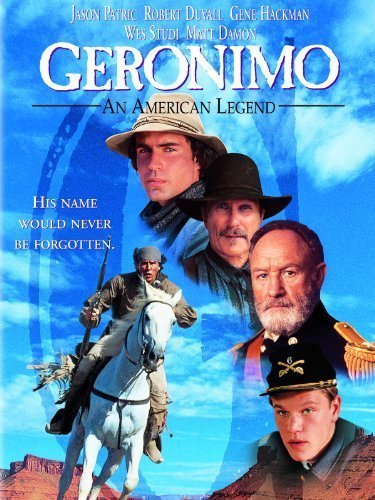
Notice the actor playing Geronimo doesn't get top billing!
Chuck 'The Rifleman' Connors played him too. I like Chuck Connors.
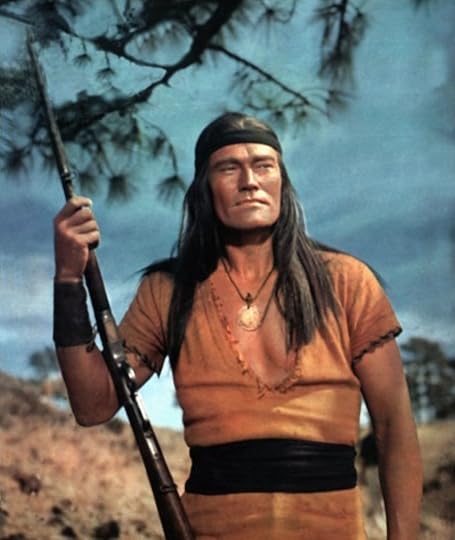
Chuck Connors as Geronimo
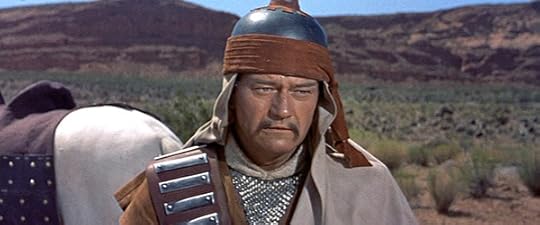
John Wayne in 'The Conqueror'
I like John Wayne. John Wayne played Genghis Khan once…'nuff said.
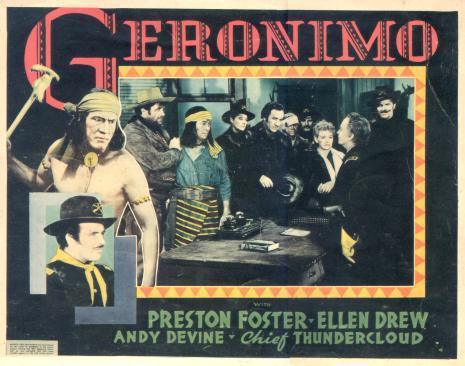
Still no top billing for the actor playing the titular character....
Geronimo's other legacy is the famous World War II paratrooper call mentioned above, which was first enacted by Georgian Private Aubrey Eberhardt of the fledgling Parachute Test Platoon at Ft. Benning. The day before his first jump out of an airplane, Aubrey and some friends watched a 1939 Paramount movie starring the imposing Victor 'Chief Thundercloud' Daniels (a Cherokee actor who originated the role of Tonto in the early Lone Ranger serials) in the titular role of Geronimo. Chided about his nervousness later by his fellows, Eberhardt promised that to prove he could sustain his courage while plummeting thousands of feet, tomorrow he would call out to them a certain phrase as he jumped, to let them know he hadn't lost his nerve.
The distinctive word he chose was 'Geronimo.'
In the months to come, as the number of trainees grew into five full blown Airborne Divisions, the paratroopers carried the battle cry to the skies over Europe. The first division to be instated, the 501st Parachute Infantry Batallion, chose the name as their motto and insignia. 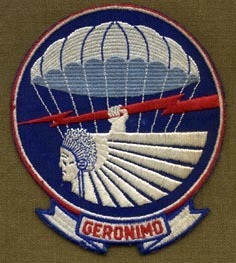 The 50th PIR also adapted the name, and Geronimo's warrior legacy (whether the soldiers were aware of it or not) landed at D-Day with the men of the 101st Airborne, who wore war paint and shaved their heads into mohawks (and still do).
The 50th PIR also adapted the name, and Geronimo's warrior legacy (whether the soldiers were aware of it or not) landed at D-Day with the men of the 101st Airborne, who wore war paint and shaved their heads into mohawks (and still do).
Colonel Byron Page of the 11th Airborne wrote the classic paratrooper cadence Down From Heaven, which goes -
Down from Heaven comes Eleven
and there's Hell to pay below
shout "GERONIMO" "GERONIMO".
It's a gory road to glory
but we're ready here we go
shout "GERONIMO" "GERONIMO".
Hit the silk and check your canopy
and take a look around
The air is full of troopers
set for battle on the ground
killed on Leyte and Luzon
shout "GERONIMO" "GERONIMO".
The 'eleven' refers to the number of jumpers in a plane (which coincidentally brings us back to Matt Smith, the 11th incarnation of Doctor Who, who yells Geronimo in his debut episode, The Eleventh Hour) . 
Nifty, huh?
And that's about all I have to say about Geronimo, the man and the phrase.
But how the hell does Geronimo fit into Merkabah Rider anyway?
1880 is dawning and The Great Old Ones are coming.
A war to clear their path is being fought in the Southwest and the Outer Gods are fielding their Native American general, Misquamacus (of The Lurker On The Threshold and The Manitou), who drifts into the San Carlos Reservation preaching victory over the invading whites. The greatest guerilla force extant is the Apache. Vittorio, Juh, and Nana are at the height of their powers, and Misquamacus calls a meeting at one of the great hidden strongholds deep within the Sierra Madres. All the Indian must do to defeat the white man and the Mexican forever is to turn from the veneration of Usen and fight for the Great Old Ones.
And among the gathered warriors is a broad, silent man with hatred in his ears, but the teachings of his murdered mother in his heart. A man who wrote;
"When a child my mother taught me the legends of our people; taught me of the sun and sky, the moon and stars, the clouds and storms. She also taught me to kneel and pray to Usen for strength, health, wisdom, and protection. We never prayed against any person, but if we had aught against any individual we ourselves took vengeance. We were taught that Usen does not care for the petty quarrels of men….while I live, I want to live well."








January 31, 2011
Protected: The Crawlin' Chaos Blues
This post is password protected. You must visit the website and enter the password to continue reading.









